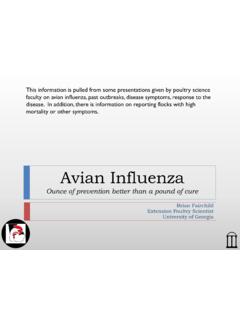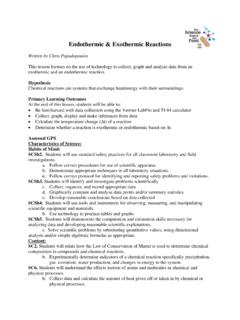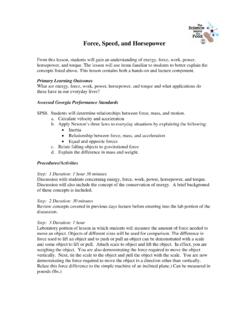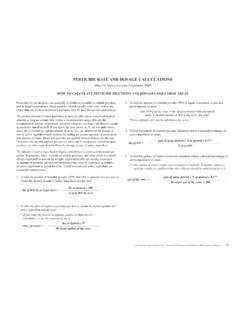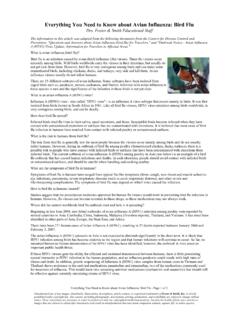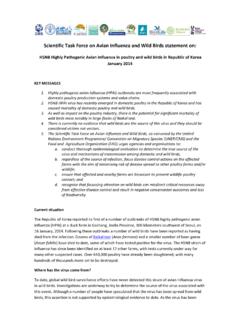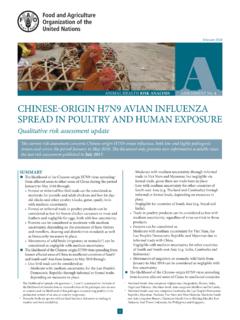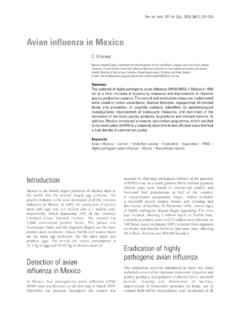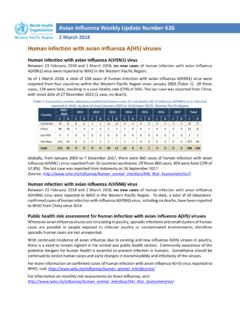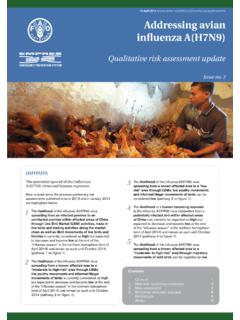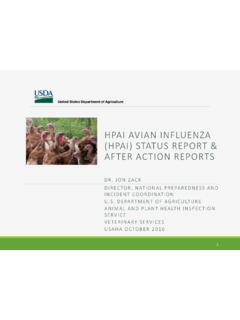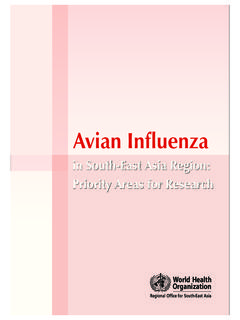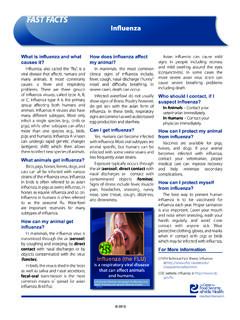Transcription of Georgia Response Plan For Highly Pathogenic Avian ...
1 Page 1 of 37 Georgia Response Plan For Highly Pathogenic Avian influenza In poultry Page 2 of 37 TABLE OF CONTENTS I. EXECUTIVE SUMMARY II. STATUTORY AUTHORITIES III. OVERVIEW AND GENERAL INFORMATION A. Overview B. General Information Dissemination IV. EXISTING Avian influenza (AI) SURVEILLANCE A. Passive Surveillance for AI in Georgia B. Active Surveillance for AI in Georgia V. DEFINITIONS OF A SUSPECT FLOCK AND POSITIVE CASE OF HPAI A. Definition of a Suspect Flock B. Definition of Positive Case of HPAI by the National Veterinary Services Laboratory VI. INITIAL SUSPECT FLOCK A. Reporting Requirements B. Company/Owner Voluntary Isolation C. Sampling of the Suspect Flock D. Epidemiology E. Notification by the State Veterinarian or the USDA AVIC VII. NEGATIVE TEST RESULT OF SUSPECT FLOCK VIII. PRESUMPTIVE POSITIVE OF HPAI A. Initial Response (first few hours) B.
2 Secondary Response (first few days) IX. CONFIRMED POSITIVE OF HPAI A. Initial Response B. Secondary Response C. Tertiary Response X. ZONES AND PREMISES A. Zones Designations B. Premises Designations XI. Response FOR DESIGNATED PREMISES A. Response for Infected Premises B. Response for Contact Premises C. Response for Suspect Premises D. Response for At-Risk Premises XII. ISSUANCE AND RELEASE OF QUARANTINES A. Issuance of Quarantines B. Release of Quarantines XIII. LABORATORY SURVEILLANCE AND DIAGNOSTICS XIV. VACCINATION XV. SAFETY AND PERSONAL PROTECTION XVI. OTHER SUSCEPTIBLE SPECIES XVII. FBI AND CRISIS MANAGEMENT XVIII. COMMUNICATION XIX. RECOVERY Page 3 of 37 XX. REVISING HPAI Response PLAN XXI. RESOURCES A. Publications B. Websites XXII. GLOSSARY XXIII. ANNEXES Annex 1: SART Concept Paper Annex 2: Georgia Dead Bird Protocol Annex 3: National Chicken Council and National poultry Improvement Plan Voluntary AI Monitoring Programs Annex 4.
3 Wildlife AI Surveillance in Georgia Annex 5: Georgia AI Surveillance Program Annex 6: Executive Summary of the Georgia H5 and H7 Low Pathogenic Avian influenza (LPAI) First Response and Containment Plan Annex 7: VS Memorandum on Reporting and Submission Requirements for All Presumptive Positive Avian influenza H5 samples Annex 8: Procedures for Investigating a Foreign Animal/Emerging Disease and an H5 Detection Event (VS Document) Annex 9: poultry Emergency Disease Management Committee Procedures Annex 10: Governor s Executive Order for HPAI Emergency Declaration Draft Annex 11: HPAI Perimeter Security Plan Annex 12: HPAI Response Procedures in Other Susceptible Species Annex 13: Respiratory Protection Program for HPAI Response Annex 14: HPAI Communication Procedures Page 4 of 37 I. EXECUTIVE SUMMARY The overarching goal of the Georgia Response Plan for Highly Pathogenic Avian influenza in poultry (Plan) is to detect, control, and eradicate an outbreak of Highly Pathogenic Avian influenza virus (HPAI) in all types of Georgia poultry .
4 For the purposes of the Plan, poultry refers to chickens, ducks, geese, swans, turkeys, pigeons, doves, pheasants, grouse, partridges, quail, guinea fowl, and pea fowl. Response to HPAI should be expedient in order to return individual farms to normal production and the State to a disease-free status. The Plan is a guide and the framework is consistent with federal guidance from the Department of Homeland Security ( National Incident Management System, National Response Plan) and the Department of Agriculture, Animal and Plant Health Inspection Service, Veterinary Services (USDA APHIS VS). The Plan is also consistent with the State of Georgia Emergency Operations Plan ( Emergency Support Function 11 Agriculture and Natural Resources, and others). Actions may be modified as deemed appropriate to meet the overarching goal.
5 The actual field circumstances surrounding a presumptive or confirmed HPAI case may require modification of Response actions specified in this Plan. The Plan references statutory authorities and provides detailed procedures for Avian influenza (AI) surveillance and emergency Response to a laboratory confirmation of a HPAI virus in Georgia poultry . The emergency Response components include quarantine and movement controls, humane euthanasia, disposal, cleaning and disinfection, biosecurity, appraisal, and compensation. The Plan also includes processes for disseminating information, addressing aspects of public health, crisis management, and other activities. Aggressive surveillance programs are in place to monitor for AI viruses in the State. All susceptible birds with unexplained illness submitted to diagnostic laboratories in Georgia are screened for AI.
6 All poultry companies producing breeding stock are participants in the National poultry Improvement Program and the majority of poultry companies participate in the National Chicken Council AI Monitored Program. In addition, birds sold in Georgia s licensed poultry sales establishments and relevant migratory waterfowl are also monitored. Georgia law requires that a clinical suspicion, local laboratory result, or other reasonable suspicion of HPAI in any bird shall be reported immediately to the Georgia State Veterinarian or the USDA Area Veterinarian in Charge (AVIC). The Office of the State Veterinarian or the USDA AVIC will assure that the owner and manager of poultry have been notified and requested that the premises be voluntarily and immediately isolated. Additional notifications will include, but not be limited to, the Georgia Agriculture Commissioner, the poultry Emergency Disease Committee (PEDC), and other appropriate Response agencies ( OHS/GEMA, GA Division of Public Health, Athens and Tifton Diagnostic Laboratories, etc.)
7 , as necessary. Strict biosecurity will be required on the affected premises and a state-issued quarantine of the premises may be issued at the discretion of the State Veterinarian or the AVIC. Samples from suspicious flocks will be immediately submitted to the USDA National Veterinary Services Laboratory (NVSL) in Ames, Iowa, for confirmation. The NVSL shall report confirmatory results to the State Veterinarian and the AVIC. The State Veterinarian and AVIC will take necessary action to contain the situation prior to receiving a confirmed positive result. Page 5 of 37 The Georgia Commissioner of Agriculture will initiate a Response cascade in the event of a positive confirmation of HPAI from the NVSL. The Office of the State Veterinarian will immediately quarantine the premises, if not already under official quarantine.
8 The State Veterinarian and the AVIC will activate the Unified Area Command (UAC) and serve as joint commanders. The UAC will set the overall objectives for controlling and eradicating the outbreak and delegate authority to the Georgia State Agriculture Response Team(s) (GA-SARTs). The State Veterinarian will formally activate the PEDC to advise and consult with the UAC. When appropriate, the Commissioner of Agriculture will request that the Governor declare an agriculture emergency to avail the resources of the Office of Homeland Security/ Georgia Emergency Management Agency and other state assets. Also when appropriate, USDA APHIS VS will initiate a request to the Secretary of USDA to declare an extraordinary emergency to avail USDA resources. In the event of agroterrorism, the UAC will fully cooperate with the FBI in their criminal investigation.
9 The GA-SART will plan and direct the Response to the incident in the field. The GA-SART will be multidisciplinary with representatives from state and federal agencies, academic institutions, non-governmental organizations, and the private sector. A control area will be established around the affected areas with various levels of movement restrictions within zones for poultry , poultry products, vehicles, related equipment, and personnel. All farms with poultry located within the control area and those with epidemiological links will be monitored for HPAI. poultry on infected premises will be humanely euthanized with proper disposal. USDA will provide compensation for poultry that are destroyed. Strict biosecurity will be required in the control area. Law enforcement personnel may be utilized to enforce state-ordered quarantines and maintain perimeter security.
10 During an outbreak of HPAI, it is imperative that accurate information be disseminated on a timely basis to keep the public well informed. Media alerts will be coordinated and disseminated through a joint information center. Information may include updates of test results, status of the outbreak and control measures, and public health information. Georgia also has a program to contain low Pathogenic H5 and H7 Avian influenza (LPAI) viruses, which typically do not cause significant sickness or death in poultry . In addition, LPAI has not been known to be a serious threat to human health. The Georgia Program for LPAI served as the basic platform for development of this Plan. The Georgia Committee on Agriculture and Food Defense, under the auspices of the State Homeland Security Task Force, has taken aggressive actions to increase awareness about foreign animal diseases, including preparedness for HPAI and the public s responsibility to report HPAI to proper officials.
